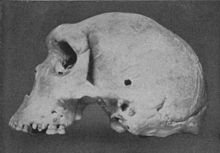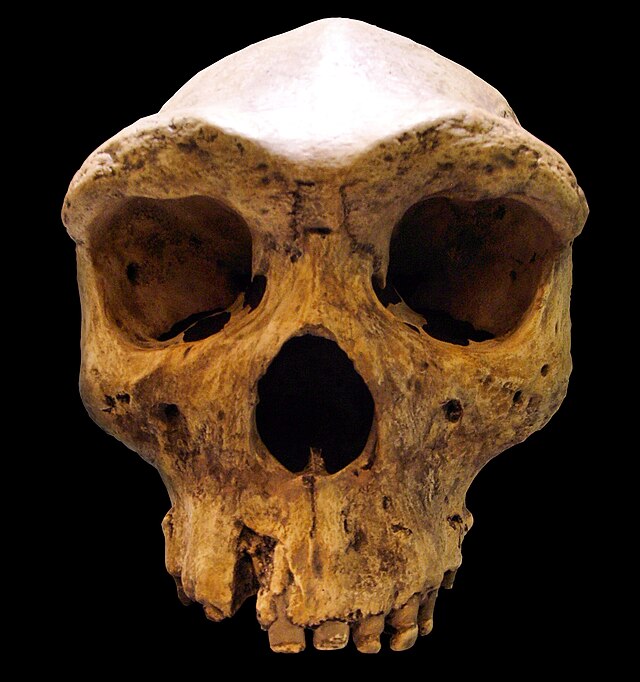Loading AI tools
Species of primate (fossil) From Wikipedia, the free encyclopedia
Homo rhodesiensis is the species name proposed by Arthur Smith Woodward (1921) to classify Kabwe 1 (the "Kabwe skull" or "Broken Hill skull", also "Rhodesian Man"), a Middle Stone Age fossil recovered from Broken Hill mine in Kabwe, Northern Rhodesia (now Zambia).[1] In 2020, the skull was dated to 324,000 to 274,000 years ago. Other similar older specimens also exist.[2]
| Homo rhodesiensis Temporal range: Middle Pleistocene | |
|---|---|
 | |
| Kabwe skull (1922 photograph) | |
| Scientific classification | |
| Domain: | Eukaryota |
| Kingdom: | Animalia |
| Phylum: | Chordata |
| Class: | Mammalia |
| Order: | Primates |
| Suborder: | Haplorhini |
| Infraorder: | Simiiformes |
| Family: | Hominidae |
| Subfamily: | Homininae |
| Tribe: | Hominini |
| Subtribe: | Hominina |
| Genus: | Homo |
| Species: | †H. rhodesiensis |
| Binomial name | |
| †Homo rhodesiensis Woodward, 1921 | |
H. rhodesiensis is now widely considered a synonym of H. heidelbergensis.[3] Other designations such as Homo sapiens arcaicus[4] and Homo sapiens rhodesiensis[5] have also been proposed.


A number of morphologically comparable fossil remains came to light in East Africa (Bodo, Ndutu, Eyasi, Ileret) and North Africa (Salé, Rabat, Dar-es-Soltane, Djbel Irhoud, Sidi Aberrahaman, Tighenif) during the 20th century.[6]
The Bodo cranium[20] is a fossil of an extinct type of hominin species. It was found by members of an expedition led by Jon Kalb in 1976.[21] The Rift Valley Research Mission conducted a number of surveys that led to the findings of Acheulean tools and animal fossils, as well as the Bodo Cranium.[22] The initial discovery was by Alemayhew Asfaw and Charles Smart, who found a lower face. Two weeks later, Paul Whitehead and Craig Wood found the upper portion of the face. Pieces of the cranium were discovered along the surface of one of the dry branches of the Awash River in Ethiopia.[20] The cranium, artifacts, and other animal fossils were found over a relatively large area of medium sand, and only a few of the tools were found near the cranium.[23][24] The skull is 600,000 years old.[25]
This specimen has an unusually large cranial capacity for its age that is estimated at around 1250 cc (in the range between ~1,200–1,325 cc) within the (lower) range of modern Homo sapiens.[26] The cranium includes the face, much of the frontal bone, parts of the midvault and the base anterior to the foramen magnum. The cranial length, width and height are 21 cm (8.3 in), 15.87 cm (6.2 in) and 19.05 cm (7.5 in) respectively. Researchers have suggested that Bodo butchered animals because Acheulean hand axes and cleavers, along with animal bones, were found at the site. Cuts on the Bodo cranium show the earliest evidence of removal of flesh immediately after the death of an individual using a stone tool.[23] The findings of symmetrical cut marks with specific patterns and directionality on the cranium serve as strong evidence that de-fleshing was done purposefully for mortuary practices and represents the earliest evidence of non-utilitarian mortuary practices.[23][27] The cut marks were located "laterally among the maxilla" causing speculation among researchers that the specific reason for de-fleshing was to remove the mandible.[28]

The front of the Bodo cranium is very broad and supports large supraorbital structures. The supraorbital torus projects and is heavily constructed, especially in the central parts of the cranium. The Glabella is rounded and projects strongly. Like Homo erectus, the braincase is low and archaic in appearance. The vault bones are also thick like Homo erectus specimens. Due to the large cranial capacity, there is a wider midvault which includes signs of parietal bossing as well as a high contour of the temporal squama. The parietal length can’t be accurately determined because that section of the specimen is incomplete. Though the mastoid is missing, insights regarding the specimen can be determined using fragments from the individual collected at the scene in 1981. The cranium’s parietal walls expand relative to the bitemporal width in a way that is characteristic of modern humans. The squamosal suture has a high arch which is present in modern human craniums as well.[29]
The cranium has an unusual appearance, which has led to debates over its taxonomy. It displays both primitive and derived features, such as a cranial capacity more similar to modern humans and a projecting supraorbital torus more like Homo erectus.[20][30][31] Bodo and other Mid-Pleistocene hominin fossils appear to represent a lineage between Homo erectus and anatomically modern humans, although its exact location in the human evolutionary tree is still uncertain.[32][33] Due to the similarities to both Homo erectus and modern humans, it has been postulated that the Bodo cranium, as well as other members of Homo heidelbergensis were part of a group of hominins that evolved distinct from Homo erectus early in the Middle Pleistocene. Despite the similarities, there is still a question of where exactly Homo heidelbergensis evolved. The increased encephalization seen in fossils like the Bodo cranium is thought to have been a driving force in the speciation of anatomically modern humans.[34][35]
Both the Bodo cranium and the Kabwe cranium share a number of similarities. Both have cranial capacities similar to, but on the low end of the range of modern humans (1250cc vs 1230cc). Both craniums have a very large supraorbital torus. These two features together suggest that they are a link between Homo erectus and Homo sapiens.[36] The morphology and the taxonomy are most similar to other specimens of type Homo heidelbergensis.[37] Both the Bodo and Kabwe specimens can be described as archaic because they retain certain features in common with Homo erectus. However, both exhibit important differences from Homo erectus in their anatomy, such as the contour of their parietals, the shape of their temporal bones, the cranial base, and the morphology of their nose and palate. While there are many similarities, there are a few differences between the specimens, including the entire brow of the Bodo cranium, particularly the lateral segments, which are less thick than the Kabwe specimen.[29]
In 2021, Canadian anthropologist Mirjana Roksandic and colleagues recommended the complete dissolution of H. heidelbergensis and "H. rhodesiensis", as the name rhodesiensis honours English diamond magnate Cecil Rhodes who disenfranchised the black population in southern Africa. They classified all European H. heidelbergensis as H. neanderthalensis, and synonymised H. rhodesiensis with a new species they named "H. bodoensis" which includes all African specimens, and potentially some from the Levant and the Balkans which have no Neanderthal-derived traits (namely Ceprano, Mala Balanica, HaZore'a and Nadaouiyeh Aïn Askar). "H. bodoensis" is supposed to represent the immediate ancestor of modern humans, but does not include the LCA of modern humans and Neanderthals. They suggested the confusing morphology of the Middle Pleistocene was caused by periodic "H. bodoensis" migration events into Europe following population collapses after glacial cycles, interbreeding with surviving indigenous populations.[38] Their taxonomic recommendations were rejected by Stringer and others as they failed to explain how exactly their proposals would resolve anything, in addition to violating nomenclatural rules.[39][40]
Seamless Wikipedia browsing. On steroids.
Every time you click a link to Wikipedia, Wiktionary or Wikiquote in your browser's search results, it will show the modern Wikiwand interface.
Wikiwand extension is a five stars, simple, with minimum permission required to keep your browsing private, safe and transparent.